Conditioning Citroen DS4 RHD 2013.5 1.G Owner's Manual
[x] Cancel search | Manufacturer: CITROEN, Model Year: 2013.5, Model line: DS4 RHD, Model: Citroen DS4 RHD 2013.5 1.GPages: 400, PDF Size: 31.86 MB
Page 5 of 400
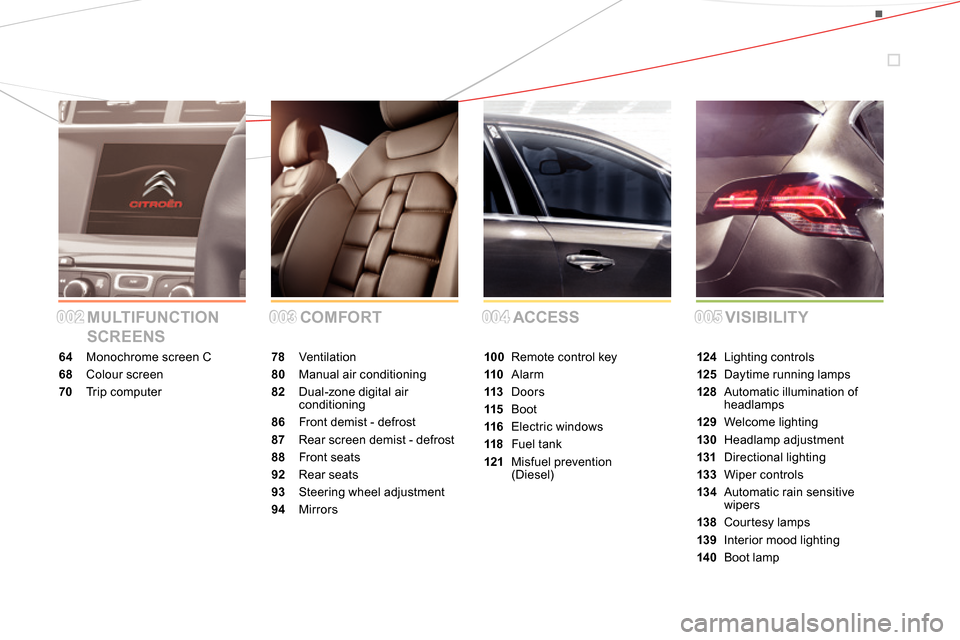
MULTIFUNCTION
SCREENSCOMFORT ACCESS VISIBILITY
64 Monochrome screen C
68 Colour screen
70 Tr i p c o m p u t e r78 Ventilation
80 Manual air conditioning
82 Dual-zone digital air
conditioning
86 Front demist - defrost
87 Rear screen demist - defrost
88 Front seats
92 Rear seats
93 Steering wheel adjustment
94 Mirrors100 Remote control key
110 Alarm
113 Doors
115 Boot
116 Electric windows
118 Fuel tank
121 Misfuel prevention
(Diesel)124 Lighting controls
125 Daytime running lamps
128 Automatic illumination of
headlamps
129 Welcome lighting
130 Headlamp adjustment
131 Directional lighting
133 Wiper controls
13 4 Automatic rain sensitive
wipers
138 Courtesy lamps
139 Interior mood lighting
14 0 Boot lamp
004004005005002002003003
Page 18 of 400
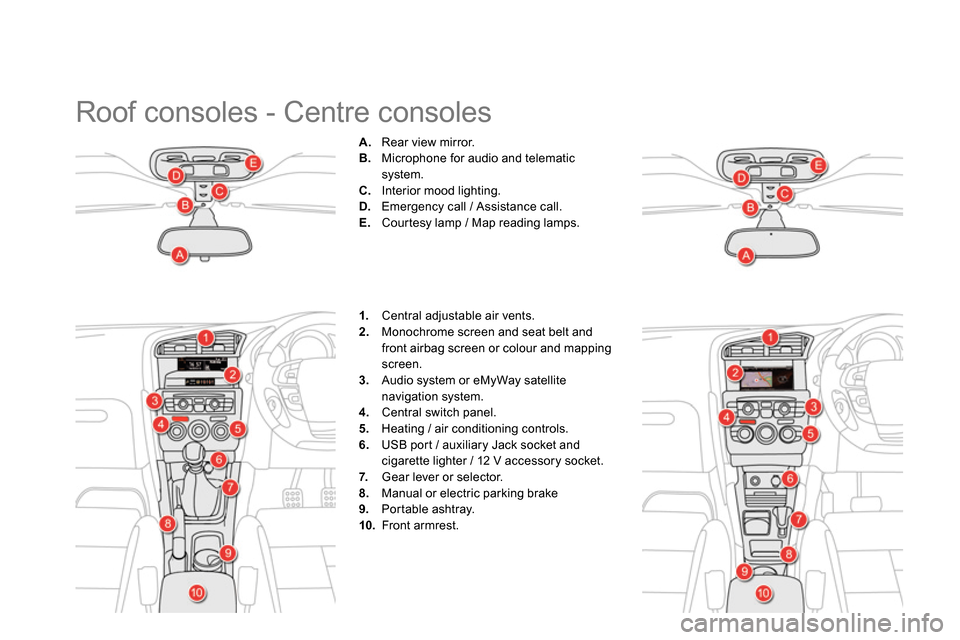
Roof consoles - Centre consoles
A.
Rear view mirror.
B.
Microphone for audio and telematic
system.
C.
Interior mood lighting.
D.
Emergency call / Assistance call.
E.
Courtesy lamp / Map reading lamps.
1.
Central adjustable air vents.
2.
Monochrome screen and seat belt and
front airbag screen or colour and mapping
screen.
3.
Audio system or eMyWay satellite
navigation system.
4.
Central switch panel.
5.
Heating / air conditioning controls.
6.
USB port / auxiliary Jack socket and
cigarette lighter / 12 V accessory socket.
7.
Gear lever or selector.
8.
Manual or electric parking brake
9.
Portable ashtray.
10.
Front armrest.
Page 24 of 400
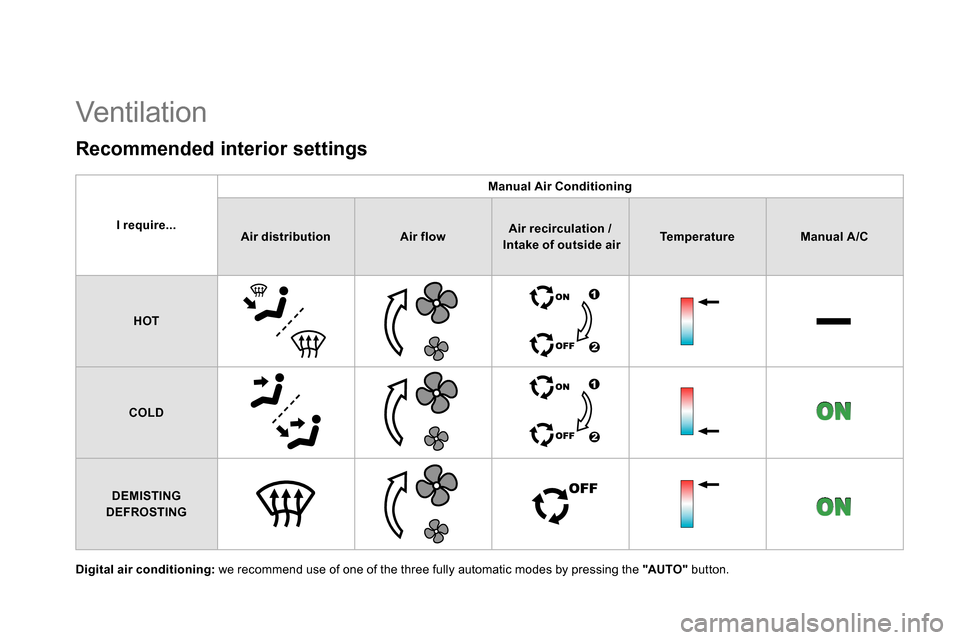
Digital air conditioning:
we recommend use of one of the three fully automatic modes by pressing the "AUTO "
button.
Recommended interior settings
I require...
Manual Air Conditioning
Air distribution
Air flow
Air recirculation /
Intake of outside air
Te m p e r a t u r e
Manual A/C
HOT
COLD
DEMISTING
DEFROSTING
Vent ilat i on
Page 36 of 400
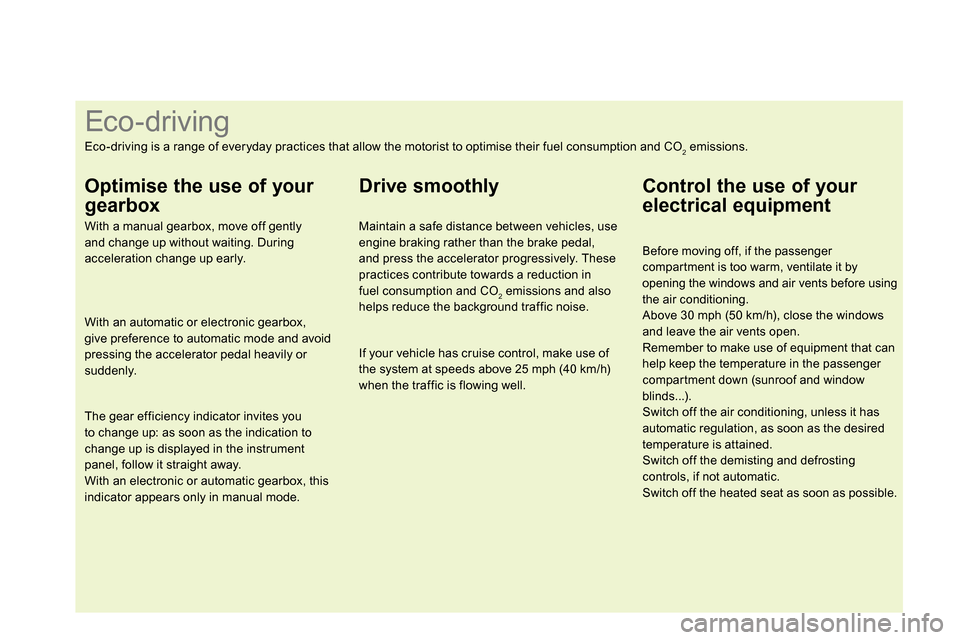
Eco-driving
Eco-driving is a range of everyday practices that allow the motorist to optimise their fuel consumption and CO2 emissions.
Optimise the use of your
gearbox
With a manual gearbox, move off gently
and change up without waiting. During
acceleration change up early.
With an automatic or electronic gearbox,
give preference to automatic mode and avoid
pressing the accelerator pedal heavily or
suddenly.
The gear efficiency indicator invites you
to change up: as soon as the indication to
change up is displayed in the instrument
panel, follow it straight away.
With an electronic or automatic gearbox, this
indicator appears only in manual mode.
Drive smoothly
Maintain a safe distance between vehicles, use
engine braking rather than the brake pedal,
and press the accelerator progressively. These
practices contribute towards a reduction in
fuel consumption and CO
2 emissions and also
helps reduce the background traffic noise.
If your vehicle has cruise control, make use of
the system at speeds above 25 mph (40 km/h)
when the traffic is flowing well.
Control the use of your
electrical equipment
Before moving off, if the passenger
compartment is too warm, ventilate it by
opening the windows and air vents before using the air conditioning. Above 30 mph (50 km/h), close the windows
and leave the air vents open.
Remember to make use of equipment that can
help keep the temperature in the passenger
compartment down (sunroof and window
blinds...).
Switch off the air conditioning, unless it has
automatic regulation, as soon as the desired
temperature is attained.
Switch off the demisting and defrosting
controls, if not automatic.
Switch off the heated seat as soon as possible.
Page 80 of 400
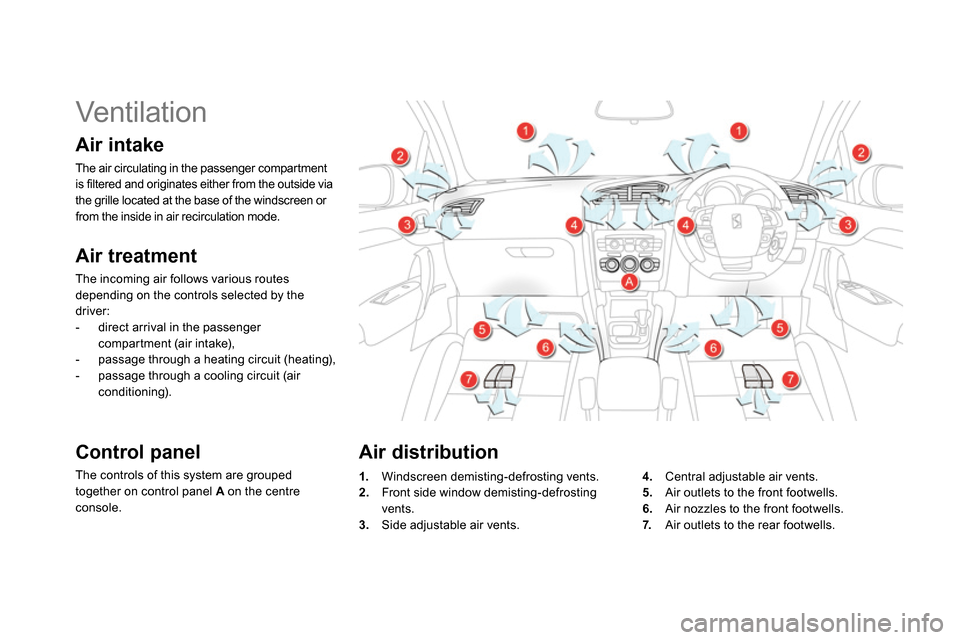
Vent ilat i on
Air intake
The air circulating in the passenger compartment
is filtered and originates either from the outside via
the grille located at the base of the windscreen or
from the inside in air recirculation mode.
Air treatment
The incoming air follows various routes
depending on the controls selected by the
driver:
- direct arrival in the passenger
compartment (air intake),
- passage through a heating circuit (heating),
- passage through a cooling circuit (air
conditioning).
Control panel
The controls of this system are grouped
together on control panel A
on the centre
console.
Air distribution
1.
Windscreen demisting-defrosting vents.
2.
Front side window demisting-defrosting
vents.
3.
Side adjustable air vents.
4.
Central adjustable air vents.
5.
Air outlets to the front footwells.
6.
Air nozzles to the front footwells.
7.
Air outlets to the rear footwells.
Page 81 of 400
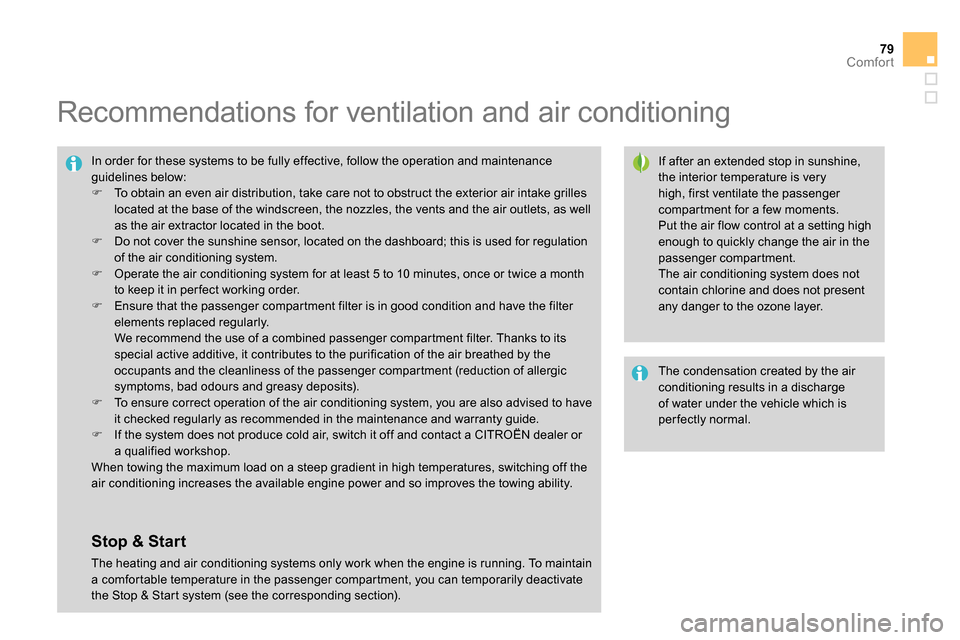
79Comfort
Recommendations for ventilation and air conditioning
If after an extended stop in sunshine,
the interior temperature is very
high, first ventilate the passenger
compartment for a few moments.
Put the air flow control at a setting high
enough to quickly change the air in the
passenger compartment.
The air conditioning system does not
contain chlorine and does not present
any danger to the ozone layer. In order for these systems to be fully effective, follow the operation and maintenance
guidelines below:
To obtain an even air distribution, take care not to obstruct the exterior air intake grilles
located at the base of the windscreen, the nozzles, the vents and the air outlets, as well
as the air extractor located in the boot.
Do not cover the sunshine sensor, located on the dashboard; this is used for regulation
of the air conditioning system.
Operate the air conditioning system for at least 5 to 10 minutes, once or twice a month
to keep it in per fect working order.
Ensure that the passenger compartment filter is in good condition and have the filter
elements replaced regularly.
We recommend the use of a combined passenger compartment filter. Thanks to its
special active additive, it contributes to the purification of the air breathed by the
occupants and the cleanliness of the passenger compartment (reduction of allergic
symptoms, bad odours and greasy deposits).
To ensure correct operation of the air conditioning system, you are also advised to have
it checked regularly as recommended in the maintenance and warranty guide.
If the system does not produce cold air, switch it off and contact a CITROËN dealer or
a qualified workshop.
When towing the maximum load on a steep gradient in high temperatures, switching off the
air conditioning increases the available engine power and so improves the towing ability.
The condensation created by the air
conditioning results in a discharge
of water under the vehicle which is
per fectly normal.
Stop & Start
The heating and air conditioning systems only work when the engine is running. To maintain
a comfortable temperature in the passenger compartment, you can temporarily deactivate
the Stop & Start system (see the corresponding section).
Page 82 of 400
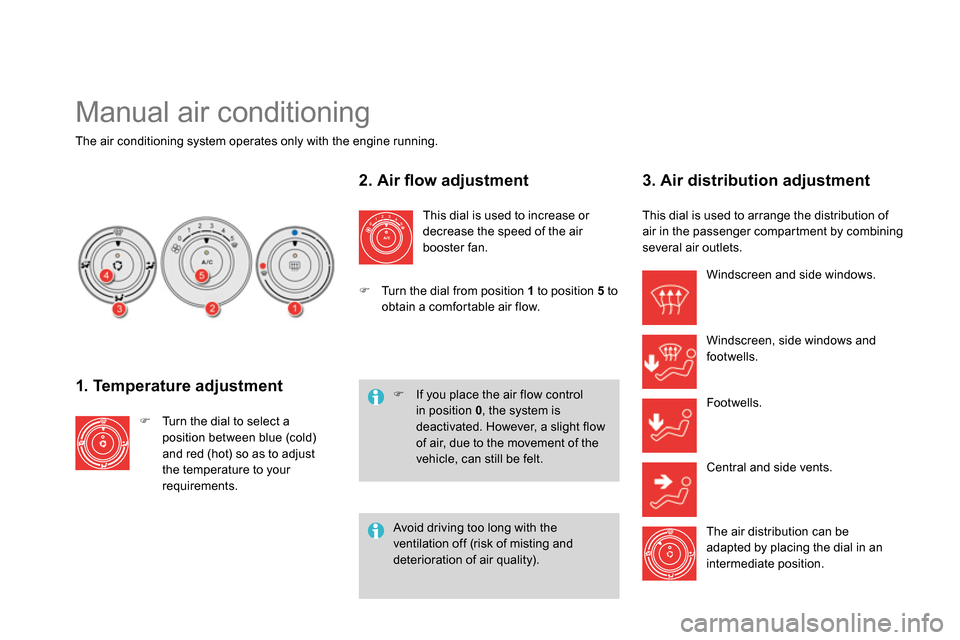
Manual air conditioning
The air conditioning system operates only with the engine running.
1. Temperature adjustment
Turn the dial to select a
position between blue (cold)
and red (hot) so as to adjust
the temperature to your
requirements.
2. Air fl ow adjustment
This dial is used to increase or
decrease the speed of the air
booster fan.
3. Air distribution adjustment
This dial is used to arrange the distribution of
air in the passenger compartment by combining
several air outlets.
If you place the air flow control
in position 0
, the system is
deactivated. However, a slight flow
of air, due to the movement of the
vehicle, can still be felt.
Turn the dial from position 1
to position 5
to
obtain a comfortable air flow. Windscreen and side windows.
Windscreen, side windows and
footwells.
Footwells.
Central and side vents.
The air distribution can be
adapted by placing the dial in an
intermediate position.
Avoid driving too long with the
ventilation off (risk of misting and
deterioration of air quality).
Page 83 of 400
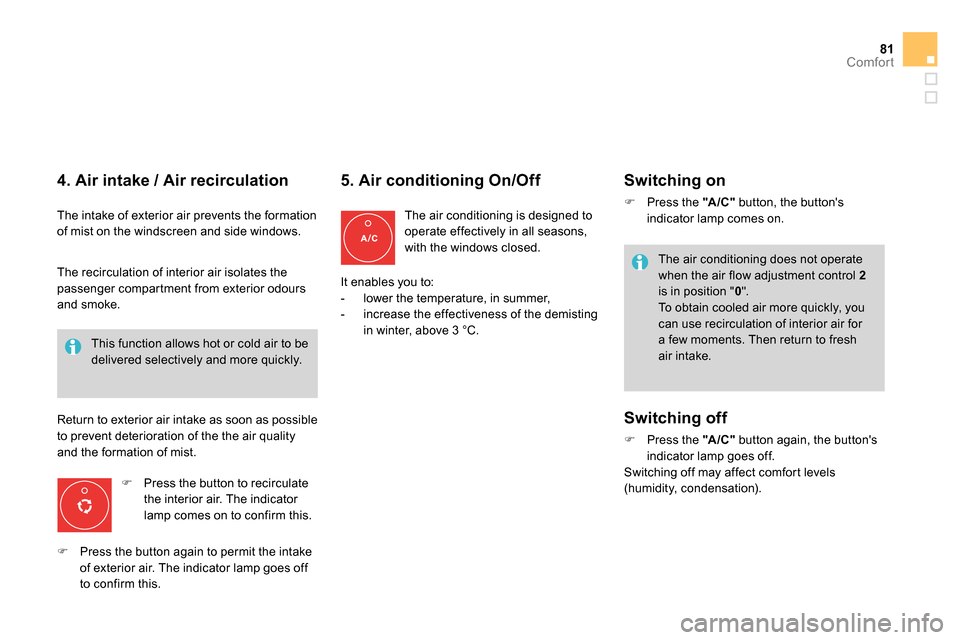
81Comfort
4. Air intake / Air recirculation
The intake of exterior air prevents the formation
of mist on the windscreen and side windows.
Press the button to recirculate
the interior air. The indicator
lamp comes on to confirm this. This function allows hot or cold air to be
delivered selectively and more quickly.
5. Air conditioning On/Off
The air conditioning is designed to
operate effectively in all seasons,
with the windows closed.
Switching on
Press the "A /C "
button, the button's
indicator lamp comes on.
The air conditioning does not operate
when the air flow adjustment control 2
is in position " 0
".
To obtain cooled air more quickly, you
can use recirculation of interior air for
a few moments. Then return to fresh
air intake. The recirculation of interior air isolates the
passenger compartment from exterior odours
and smoke.
Return to exterior air intake as soon as possible
to prevent deterioration of the the air quality
and the formation of mist.
Press the button again to permit the intake
of exterior air. The indicator lamp goes off
to confirm this.
It enables you to:
- lower the temperature, in summer,
- increase the effectiveness of the demisting
in winter, above 3 °C.
Switching off
Press the "A /C "
button again, the button's
indicator lamp goes off.
Switching off may affect comfort levels
(humidity, condensation).
Page 84 of 400
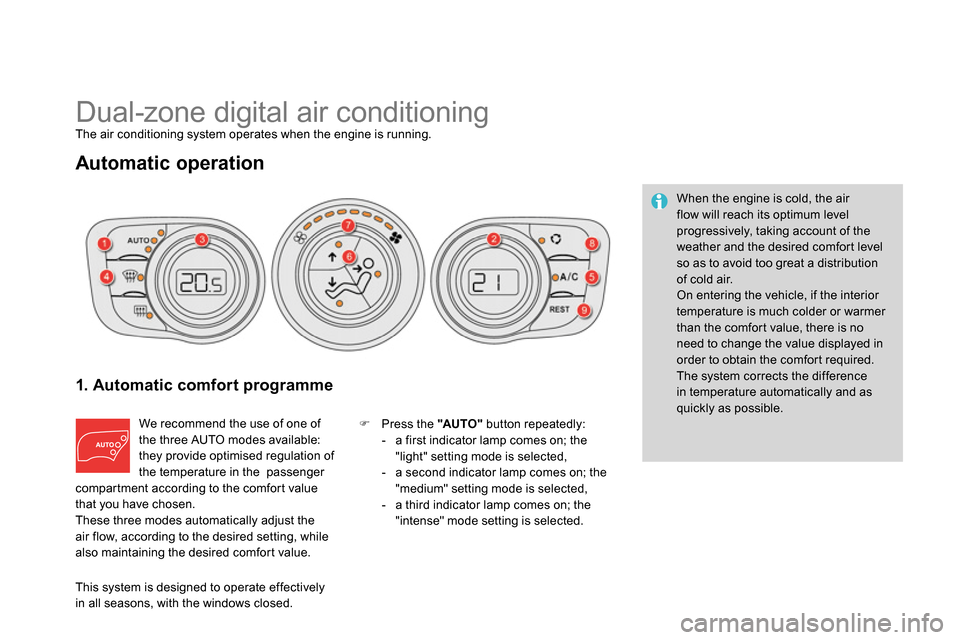
Dual-zone digital air conditioning
The air conditioning system operates when the engine is running.
Automatic operation
1. Automatic comfort programme
We recommend the use of one of
the three AUTO modes available:
they provide optimised regulation of
the temperature in the passenger
compartment according to the comfort value
that you have chosen.
These three modes automatically adjust the
air flow, according to the desired setting, while
also maintaining the desired comfort value.
Press the "AUTO "
button repeatedly:
- a first indicator lamp comes on; the
"light" setting mode is selected,
- a second indicator lamp comes on; the
"medium" setting mode is selected,
- a third indicator lamp comes on; the
"intense" mode setting is selected.
When the engine is cold, the air
flow will reach its optimum level
progressively, taking account of the
weather and the desired comfort level
so as to avoid too great a distribution
of cold air.
On entering the vehicle, if the interior
temperature is much colder or warmer
than the comfort value, there is no
need to change the value displayed in
order to obtain the comfort required.
The system corrects the difference
in temperature automatically and as
quickly as possible.
This system is designed to operate effectively
in all seasons, with the windows closed.
Page 86 of 400
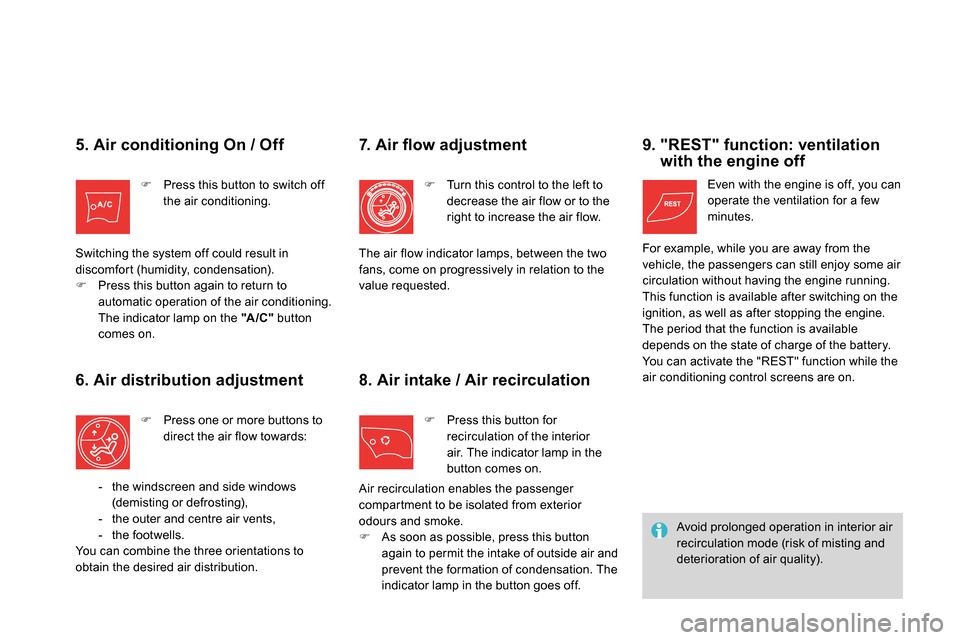
5. Air conditioning On / Off
Press this button to switch off
the air conditioning.
Switching the system off could result in
discomfort (humidity, condensation).
Press this button again to return to
automatic operation of the air conditioning.
The indicator lamp on the "A /C "
button
comes on.
6. Air distribution adjustment
Press one or more buttons to
direct the air flow towards:
- the windscreen and side windows
(demisting or defrosting),
- the outer and centre air vents,
- the footwells.
You can combine the three orientations to
obtain the desired air distribution.
7. Air fl ow adjustment
Turn this control to the left to
decrease the air flow or to the
right to increase the air flow.
8. Air intake / Air recirculation
Press this button for
recirculation of the interior
air. The indicator lamp in the
button comes on. The air flow indicator lamps, between the two
fans, come on progressively in relation to the
value requested.
9. "REST" function: ventilation
with the engine off
Even with the engine is off, you can
operate the ventilation for a few
minutes.
Air recirculation enables the passenger
compartment to be isolated from exterior
odours and smoke.
As soon as possible, press this button
again to permit the intake of outside air and
prevent the formation of condensation. The
indicator lamp in the button goes off.
For example, while you are away from the
vehicle, the passengers can still enjoy some air
circulation without having the engine running.
This function is available after switching on the
ignition, as well as after stopping the engine.
The period that the function is available
depends on the state of charge of the battery.
You can activate the "REST" function while the
air conditioning control screens are on.
Avoid prolonged operation in interior air
recirculation mode (risk of misting and
deterioration of air quality).